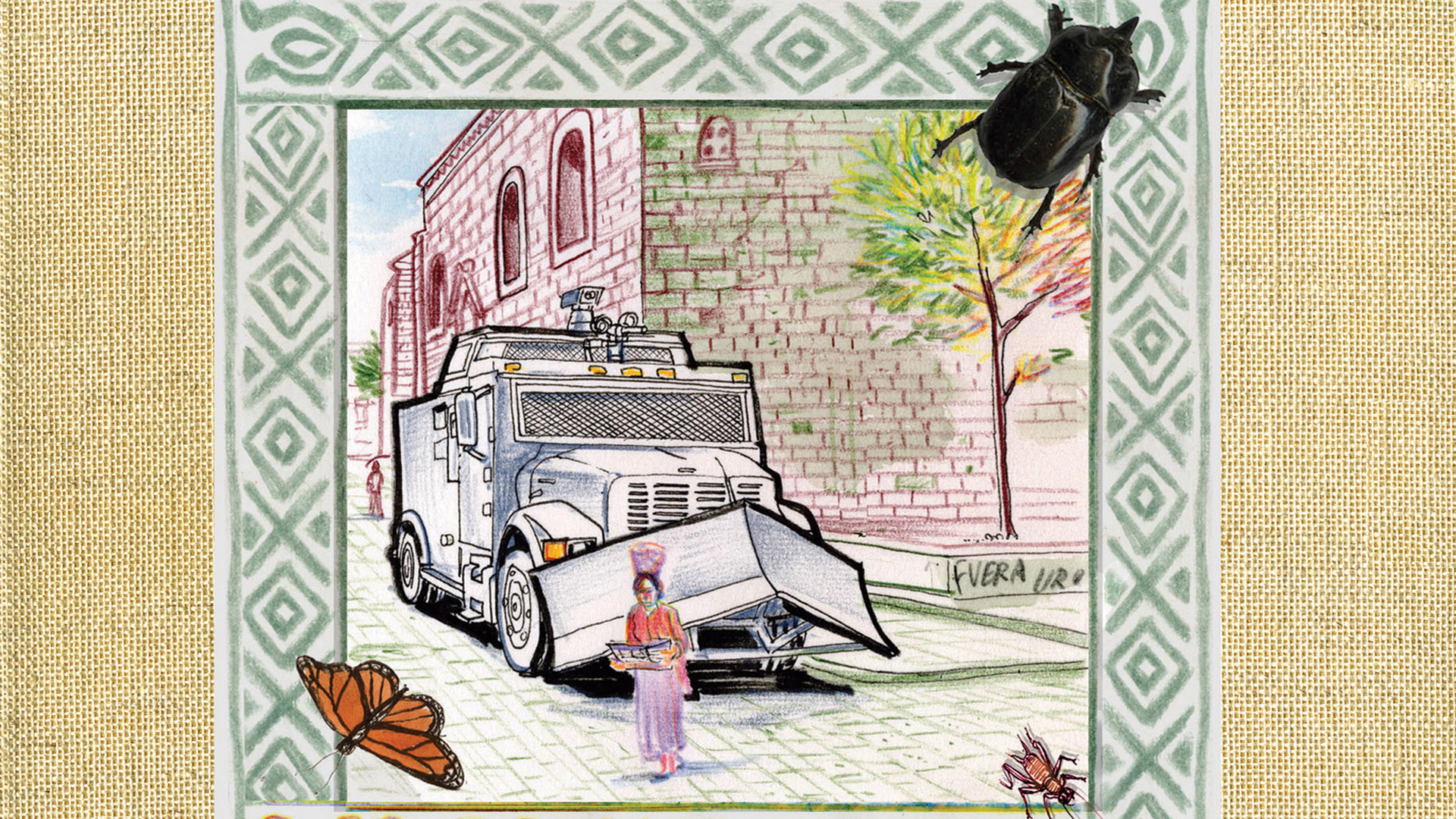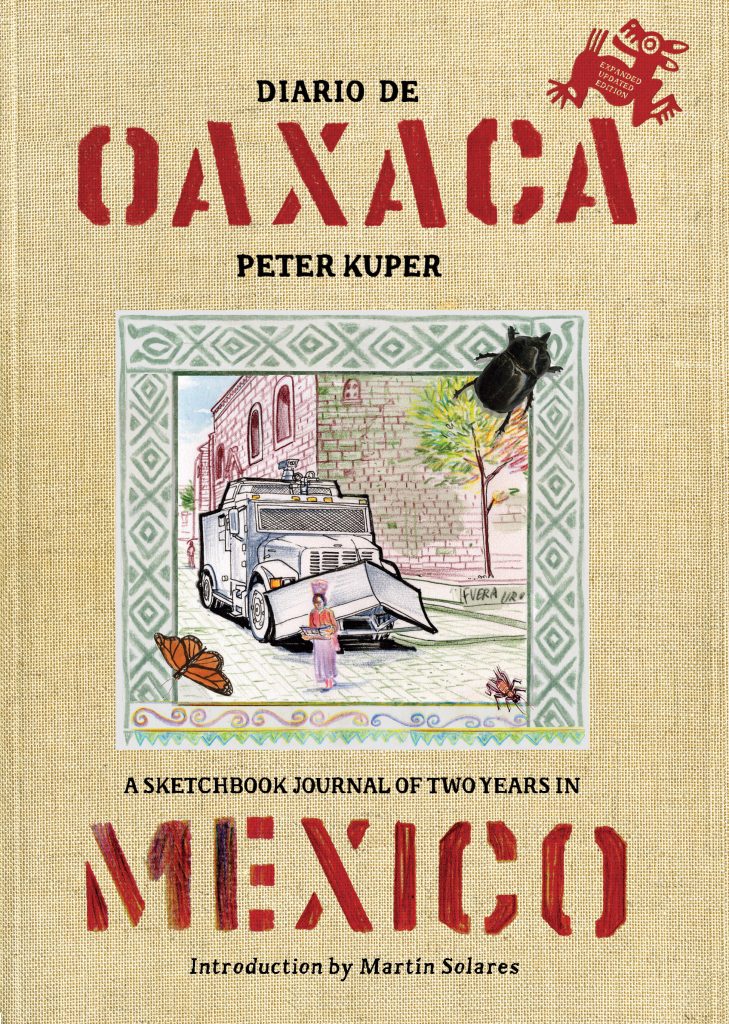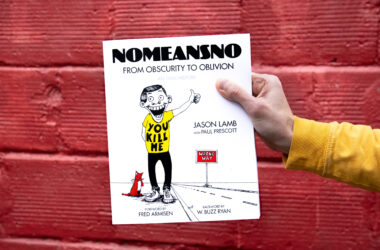By Peggy Roalf
DART: Design Arts Online
When Peter Kuper, the cartoonist widely known for his Spy Vs. Spy strip in MAD magazine, told me that he was moving his family to Oaxaca City, Mexico three years ago, I asked if he would be interested in posting stories for DART. Without hesitation, he agreed, and his first article appeared on November 10, 2006. The last story, Oaxaca Journal V. 14, was published in June 2008.
Cover and inside pages from Peter Kuper’s Diario de Oaxaca.
Next week, Peter will celebrate the publication of Diario de Oaxaca: A Sketchbook Journal of Two Years in Mexico. Here’s a report on the chat we had by email this week about his experience.
Peggy Roalf: Why did you move to Mexico?
Peter Kuper: The main reason was for our daughter, Emily. We wanted her to get a second language and be in a place with fewer iPods and cell phones. She was nine when we made the move in 2006, a time when her young mind was able to easily pick up a new language. My parents had done something similar when I was ten and we lived in Israel for a year. It had a huge impact on my world view. Being a stranger in a strange land (I got beat up a lot) and having to decipher the complex symbols of a new language, helped me grow up to be a freelance cartoonist!
PR: As a political junkie, your timing couldn’t have been better, or worse as it happened – all of which is covered in Diario De Oaxaca. After the teachers’ strike and subsequent violence ebbed, did you have to decompress before getting into the natural features and the archeological and historic wonders of Mexico – and something like a daily routine?
PK: Of course we had no idea we’d be stumbling into an exploding political situation when we picked Oaxaca. To recap: a few weeks before we arrived, Oaxaca’s new governor attacked a small teachers’ strike causing a coalition of other unions to join them in solidarity. It expanded into an international event when an American journalist was killed and federal troops were brought in by the thousands. I thought our time in Mexico would be a break from the barrage of depressing news we’d been getting since George W. Bush took office. Yet after months of living in Oaxaca, in the center of a political maelstrom, I was reminded of how important news events are to inspiring my art. In the aftermath I was in fact less motivated to draw. After sketching soldiers and tanks juxtaposed in front of ancient architecture, normal life seemed visually trivial by comparison. I eventually rediscovered the million details of daily life well worth drawing, but it took me months after the strike ended to appreciate this and get rolling.
PR: Diario includes a couple of wordless strips, including one about going for a walk that is almost a mini-epic. Is this something new for you? And are you planning anything as a stand alone publication along this vein?
PK: Wordless comics are an area of great interest to me since they transcend language barriers and are the roots of the form. Cave paintings, the Mayan codices and Egyptian hieroglyphics are a few examples of human’s earliest visual storytelling. I’ve done a couple of long form wordless graphic novels (The System and Sticks and Stones), and there are many examples of longer works by other artists in this form like Lynd Ward, Franz Masereel and Eric Drooker. The last issue of World War 3 lllustrated (which I co-edited) is all wordless comics; this was a result of my time in Mexico, and wanting to produce an issue that could be read everywhere, without translation. In fact I’m not even writing this answer–it is a wordless mind transmission.
PR: Would you consider doing a graphic novel about how the people of Teotihuacan vanished, which you mention in Diario?
PK: I’m developing a new fictional graphic novel based on my experiences in Mexico and I’m weaving history into the story so I can go beyond constraints of reality. But I’d consider do any number of things that would allow me to sit at my drawing table in New York and mentally travel in Mexico!
PR: You speak of the Mexican world of simultaneity on page 180, in which people celebrate their ancient heritage as they go about their daily routine. Have you brought any of that lifestyle back home?
PK: I’ve tried to bring aspects of that into my drawings. I’m trying to keep up with my daily sketchbook drawing as I did in Mexico, only here in New York, I’m mixing subway riders with floating skyscrapers, poor people on cell phones next to rich people on Blackberries. Still, somehow it doesn’t feel the same; we’re missing the truly ancient.
PR: After living there for so long, was drifting into the tourist mode hard to do?
PK: Not really. I still feel like a tourist here in New York after 32 years. What was difficult was going from feeling like part of the town during the strike, (since so few foreigners stuck around during the troubles) to feeling like another gringo when the strike ended and the town was flooded with tourists again.
PR: The drawings toward the end of the book are more highly finished than your early sketches. Did you create these after returning to New York? Or did your sketchbook style evolve through daily practice?
PK: It was an evolution. I did everything but the last few pages of the book while I was in Mexico and as often as possible drew on the spot. By drawing in my sketchbook so much I learned how to turn “mistakes” into part of the page. Some of the pages took weeks to complete since I’d hop to a new page, then return to the older drawings, and continue building them over time. I tried to avoid the tendency to get precious with any single page, but occasionally I’d have to set my coffee cup on the art and let it leave a stain – as a reminder that this was still a sketchbook.
PR: Please tell DART readers about the hearts on the end pages, which are also scattered throughout the book.
PK: The owner of the house we rented collected painted tin hearts, created by artisans for various holidays. They were stuck in nooks around the house so they became one more thing for me to draw. When I looked at my sketches later the hearts seemed emblematic of Mexico – hand-made, colorful, sometimes garish, religious overtones bent to form something personal that felt ancient, symbolic and beautiful – so I used them as endpapers in my book.
PR: Like a Mexican version of mezuzahs?
PK: They are called “Milagros,” which translates into charms; some of them reference Jesus by surrounding the heart with a crown of thorns and He was jewish so….
PR: What are your plans for this year’s Day of the Dead, a festival that features so vividly in the book?
PK: Since both my parents died during the last year, I will have a full schedule of celebrating their lives and welcoming their spirits back for a visit over a mezcal, which is an extremely potent liquor made from the agave cactus.
PR: How would you characterize the effects of spending two years away from your New York life?
PK: It’s hard for me to determine given how many other forces have been at work since our return. The economic crash, my parents dying, the changing political climate and my own artistic metamorphosis, which is still taking place, has made it difficult to separate the impact of our time in Mexico from the seismic world shift that everyone is experiencing. It has been over a year since we returned and I am only just feeling my feet settling back on the city pavement.
PR: What advice would you give to others who want to re-root for an extended period of time?
PK: Get as much language under your belt as possible to help you get your footing. Through the internet find out as much as you can about the place and make connections with locals and other travelers before you go. Also, bring plenty of quality sketchbooks!
PR: I didn’t see a book design credit – did I overlook something?
PK: I did the design, with a bit of help on typography from a Mexican designer. The Mexican publisher let me have all the bells and whistles I wanted and I ran with it. The U.S. publisher came on the scene later. They were both so hands off that I ended up dealing with every aspect of the book from finding the printer to negotiating the shipping!
PR: Well congratulations again, Peter, and I’d like to tell DART readers what a remarkable book this is – certainly one that I’ll treasure.
Editor’s note: Peter Kuper will be doing a series of events around Diario de Oaxaca including an exhibition of original art that will open at MOCCA (The Musum of Comic and Cartoon Art) next Thursday, September 17th at 7:00 pm, with a talk and book signing. For complete details, click here.
Buy Diario de Oaxaca: A Sketchbook Journal of Two Years in Mexico:






